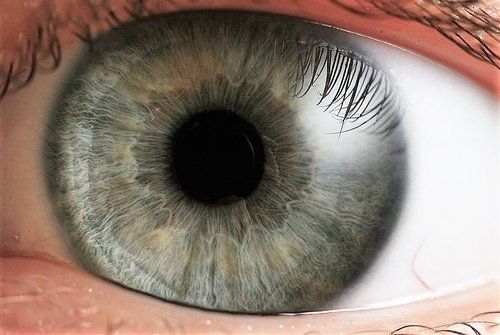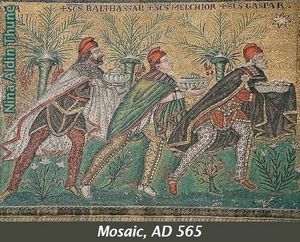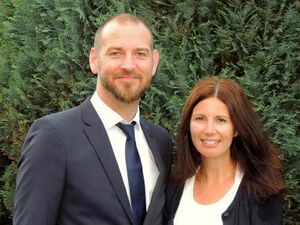
Our eyes are wonderful things! Each one is a slightly asymmetrical globe, about an inch in diameter. The front part of the eye that you see in the mirror contains the iris (the pigmented part), the cornea (a clear dome over the iris), the pupil (the black circular opening in the iris that lets light in), the sclera (the white part), and the conjunctiva (a thin layer of tissue covering the front of the eye, except the cornea).
Just behind the iris and pupil lies the lens, which helps to focus light on the back of the eye. Most of the eye is filled with a clear gel called vitreous. Light projects through the pupil and the lens to the back of the eye.
Eye
The inside lining of the eye is covered by special light-sensing cells that are collectively called the retina. The retina converts light into electrical impulses. Behind the eye, the optic nerve carries these impulses to the brain. The macula is a small sensitive area within the retina that gives central vision. It is located in the centre of the retina and contains the fovea, a small depression or pit at the centre of the macula that gives the clearest vision.
Eye colour is created by the amount and type of pigment in the iris. Multiple genes inherited from each parent determine a person’s eye colour. All of which proves so right the words of the psalmist David about God: ‘For you formed my inward parts; you covered me in my mother’s womb. I will praise you, for I am fearfully and wonderfully made; marvellous are your works, and that my soul knows very well’ (Psalm 139:13-14).
Jesus and Simeon
But something even more wonderful than physical sight is to see spiritually.
One of the lesser known characters in the story of Jesus’ early years is an elderly man named Simeon. You can read all about him in the Gospel of Luke chapter 2, verses 25-35. We’re told the Holy Spirit had revealed to Simeon that he wouldn’t die until he had seen the Messiah, and that when Mary and Joseph brought the child Jesus into the temple he took Jesus up in his arms, praised God, and said (among other things), ‘My eyes have seen your salvation’ (Luke 2:30).
Now, in one sense, Simeon had a privilege none of us do — to see the Messiah with his physical eyes. What a moment that must have been for this aged man of God. Yet, that said, we can share most definitely in Simeon’s experience. For in Jesus, with the eye of faith, salvation may be seen, tasted and enjoyed.

Eyes wide open
Have you ever played the game where children pretend to be blind? They close their eyes, and what do they see? It’s not that they literally can’t see anything, but it’s very dark. There may be specks of light here and there, but whatever they can or can’t see, nothing really makes much sense. That’s how we are by nature: blind to our own sinfulness and guilt, and blind to the wonder of salvation in and through the Lord Jesus Christ.
Jesus’ many healing miracles included giving sight to the blind. Sometimes it happened in an instant: he simply touched their eyes and they could see. On other occasions it was more gradual — like the man who said he saw trees walking, and then in due course could see everything clearly.
Spiritually, that’s what happens when someone becomes a Christian. Whether immediately or over a period of time, our spiritual eyes are opened. We see ourselves as we’ve never seen ourselves before, and we see Jesus as we’ve never seen him before.
Have you ever seen yourself as a sinner, who has offended a holy God and who deserves only the righteous judgment of the Almighty in hell for ever? And have you ever seen who Jesus is, why he came and what he’s about? The apostle Paul declares: ‘Christ Jesus came into the world to save sinners’ (1 Timothy 1:15). Have you ever turned from your sin in faith to the Saviour Jesus, and trusted him with your heart, your life, your eternity and your all?

‘Eureka!’
Archimedes is famous for his ‘eureka’ moment. The story goes that the ancient Greek mathematician and inventor stepped into the bath and noticed that the water rose, whereupon he suddenly understood that the volume of water displaced must be equal to the volume of the part of his body he had submerged.
He then realised that the volume of irregular objects could be measured with precision — a previously intractable problem. He is reported to have shouted ‘Eureka! Eureka!’ and been so eager to share his discovery that he leapt out of his bath and ran naked through the streets of Syracuse!
A rough translation of eureka is ‘I see it!’ — but do you? Simeon’s testimony is that he saw in Jesus the salvation of the Lord. Do you see it?
Invitation
When you see what a sinner you are and what a Saviour Jesus is, then you’ll love him, want him, and be unable to keep yourself back from coming and casting yourself entirely upon him.
Jesus lived the life you’ve failed to live. He died for sin that you might have life. He lives forever and is able and willing to save. He’s all you’ve been waiting for, and he invites you to come in faith to him.
He says: ‘Come to me, all you who labour and are heavy laden, and I will give you rest. Take my yoke upon you and learn from me, for I am gentle and lowly in heart, and you will find rest for your souls. For my yoke is easy and my burden is light’.
Jeremy Brooks is pastor of Welcome Hall Evangelical Church, Bromsgrove. He also serves as chairman of EP Books. Married to Lydia, they are blessed with eight children.


















